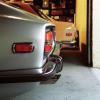Search the Community
Showing results for tags 'spring_rates'.
-
Hey all, I took my 240Z to the track last weekend, and because it was a bit wallowy at high speeds and had a lot of body roll, I'm now looking into changing up my spring rates. Current setup: 200 lb/in front springs 22mm front sway bar 250 lb/in rear springs no rear sway bar pretty thin RCAs on the front (18.5mm) lowered somewhat but not a ton 205/55R16 bridgestone RE-11s Koni yellow single-adjustable (rebound only) race shocks -2.0º camber front and rear 2.5º caster (can't run more until I modify bodywork or relocate strut mounts rearward) 0 toe front 1/16" total toe in rear Next steps I was initially thinking of: put thicker (30mm) RCAs back on increase spring rate to 300 front, 350 rear (or even 350F, 400R) add a rear strut brace (front has a triangulated strut brace already) However, I was reading about tender + main spring setups and they seem really interesting (To be clear, I'm using the same terms Eibach is here: helper springs: soft, just keep main springs seated at full droop. tender springs: have sufficient spring rate to impact driving under other conditions; I've noticed that some people use these terms the other way around). It sounds like it could provide a good compromise between a car that corners fairly flat and doesn't move around to much on load transitions, but still has higher ability to absorb bumps well. One setup I was thinking of was: 350# main springs in the front, with #300 tenders, yielding an ~160# effective rate until the tenders reach coil bind. And something similar in the back. But, I also see lots of downsides: it seems like with the simple shocks I'm using, you'll only be valved decently for either the soft or the firm part of the range. it seems like this setup would actually be worse than my current setup for high speed stability by reducing the effective rate in those conditions. the bump absorbing ability would only be improved when the suspension isn't already compressed, so it does nothing to help when cornering near the limit and hitting some uneven pavement, i.e. conditions where you actually want this. the sudden transition from 160# to 350# spring rate after an inch or so of compression sounds like a great way to unsettle the chassis. Anyone here have any experience experimenting with a setup like this? It sounded good on the face of it, but I'm not convinced it can work. But if it can't, then why does these setups exist? Is it just another compromise between comfort and handling, or are there actual rear-world handling benefits from a setup like this? My goals for the car are: 1: fun to drive on back roads, and okay to drive on regular streets and highways. and that performs well enough on the track that it's fun to push it to its traction limit (which it wasn't really with the high amount of roll and floatyness I got last weekend) doesn't have be super comfortable on our pothole ridden California highways, but I do want to be able to drive it fast-ish on less than perfect surfaces, so it should be compliant enough for tires to remain in contact with the road most of the time. Some pics to show the amount of roll:
- 25 replies
-
- suspension
- spring_rates
-
(and 4 more)
Tagged with:
